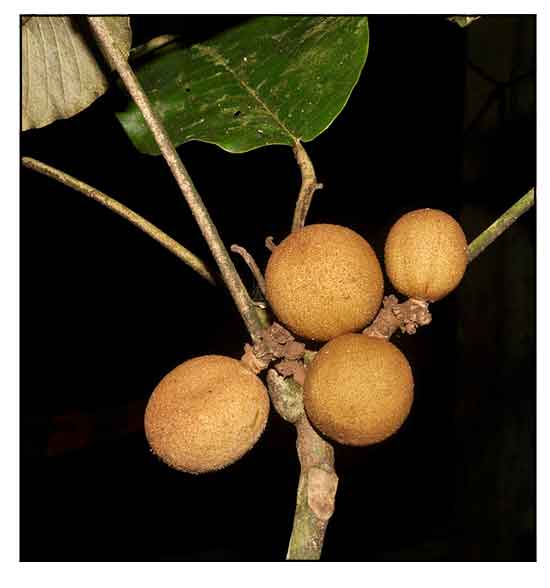 Gen info Gen info
- Aglaia argentea is a species of plant in the family Meliaceae.
- The genus Aglaia contains about 120 species, one of the largest genera of the family Meliaceae (the mahogany plants).
-
The plant is locally known as "Iloilo". The tree was name Iloilo when the Spanish friar and botanist Francisco Manuel Blanco (1778-1845) found the plant growing abundantly in the province.
- Etymology: The genus name Aglaia derives from Greek, which means splendor or beauty, and may also refer to one of the three Graces in Greek mythology. Specific epithet argentea is Latin argente, meaning silvery, referring to the silvery underside of the leaflets. (3)
Botany
• Aglaia argentea is a small to medium-sized tree up to 30 m tall, bole branchless for up to 18 m, up to 60 cm in diameter, buttresses up to 1 m high, bark surface brown or grayish-green, inner bark white, yellow or brown. Leaflets 9-19, subopposite, with 11-25 pairs of secondary veins, smooth, glabrescent above, below densely covered with white and some brown peltate scales, often having a short fimbriate margin. Flowers 5-merous, anthers 5, style-head subglobose or ovoid, longitudinally ridged. Fruit indehiscent, 2(-3)-locular. (2)
• Aglaia argentea is an evergreen tree. It has a spiral leaf arrangement and pinnately compound leaves with leaflets that are elliptical or oblong. Once it has reached a height of about 4.5 meters they begin to flower and fruit. It is a dioecious species so there are male and female plants. The flowers on both are similar, having 5 petals each. The male flowers have 5 stamen and the female flowers have superior ovaries. The fruit are small (between 30 and 35 mm in diameter) oval and fleshy, each containing anywhere from one to three seeds. The tree can grow up to 98ft (30m) and the leaves typically range in size from 17 – 112 cm long and 14 – 75 cm wide. The flowers have a complex inflorescence that can grow up to 60cm long and 60cm wide, with radial symmetry.
Distribution
- Native to the Philippines.
- Also native to Andaman Is., Borneo, Jawa, Lesser Sunda Is., Malaya, Maluku, Myanmar, New Guinea, Nicobar Is., Philippines, Queensland, Solomon Is., Sulawesi, Sumatera, Thailand, Vietnam. (1)
- Scattered in primary or secondary evergreen to semi-evergreen forests from sea level up to 1300 m.
 Constituents Constituents
- Study of stem bark isolated two new protolimonoid compounds, namely, argentinin A (1) and B (2) along with five known triterpenoid compounds, dammar-24-en-3α-ol (3), 3-epi-cabraleahydroxy lactone (4), (E)-25-hydroperoxydammar-23-en-3β,20-diol (5), mixture of eichlerianic acid and shoreic acid (6a and 6b), and dammar-24-en-3α,20-diol (7). (see study below) (7)
- Study of bark isolated five steroids: stigmast-5-en-3β-ol (β-sitosterol) (1), stigmast-5-en-3β-ol-3β-oleate (β-sitos- terol oleate) (2), stigmast-5-en-3β-ol-3-O-(6′-O-oleoyl)-β-D-glucopyranoside (sitoindoside II) (3), stigmast-5-en-3β-ol-3-O-β-D-glucopyranoside (β-sitosterol glucoside) (4), stigmast-5,22-dien-3β-ol-3-O-β-D-glucopyranoside (stigmasterol glucoside) (5). (see study below) (8)
- Study of n-hexane extract of stem bark
yielded an aroma dendrane-type sesquiterpenoid compound, spathulenol. (see study below) (10)
- Study of stem bark isolated two dammarane-type triterpenoids,
20S,24S-epoxy-3α,25-dihydroxydammarane (1) and 3α-acetyl-20S,24S- epoxy-3α,25-dihydroxydammarane (2), which showed cytotoxicity against P-388 murine leukemia cell lines. (11)
- Study of methanolic extract of stem bark isolated four dammarane-type triterpenoid compounds, dammar-24-en-3a-ol (1), 3-epi-cabraleahydroxy lactone (2), (E)-25-hydroperoxydammar-23-en-3b,20-diol (3), and dammar-24-en-3β,20-diol (4). (12)
Properties
- Studies have shown cytotoxic properties.
 Uses Uses
Edibility
- Fruit is edible, eaten raw.
-
Aril of the seed is edible, soft, fleshy, white, sweet or sour.
- Wood decoction drunk as tea. (4)
- Flower used for making tea.
Folkloric
- No reported folkloric medicinal use in the Philippines.
- Used for treatment of fever; preparations to treat leprosy. (4)
- Flower preparations used for treating flatulence, coughing, dizziness. (6)
- In Indonesia, plant traditionally used to moisturize the lungs, reduce fever, treat contusions, cough, and skin diseases. (8)
Others
- Wood: Wood is attractive, hard, durable. Used for house posts, beams, window sills, joists, rafters, flooring, agricultural implements, fine furniture, cabinetry, etc. Use as substitute for mahogany. (5)
- Agroforestry: A great colinizer for regenerating forests and wildlife in damaged rainforests. (3)
Studies
• Protolimoid Compounds / Cytotoxic Effect Against P-388 Murine Leukemia Cells / Stem Bark: Study of stem bark isolated two new protolimonoid compounds, namely, argentinin A (1) and B (2) along with five known triterpenoid compounds. All compounds were tested for cytotoxic effects against P-388 murine leukemia cells in vitro. Argentinin A (1) showed strongest activity with IC50 of 1.27 µg/mL (3.05 µM). (see constituents above) (7)
• Cytotoxic Steroids / Against P-388 Murine Leukemia Cells / Bark: Study of bark isolated five steroids. All compounds were evaluated for cytotoxic effects against P-388 murine leukemia cells. Compounds 1-5 showed cytotoxicity with IC50s of 12.45, 85.25, >100, 52.27, and 62.52 µg/ml, respectively. (see constituents above) (8)
• Cytotoxic Rocaglate / Stem Bark: Study of extracts of dried stem bark isolated a rocaglate compound. The ethyl acetate extract showed strongest activity against P-388 murine leukemia cells with IC50 of 15.5 mg/mL. High resolution MS analysis identified the compound as a methyl rocaglate, which showed strong cytotoxicity with IC50 of <0.1 µg/mL. (9)
• Cytotoxic Sesquiterpenoid / Stem Bark: Study of n-hexane extract of stem bark
yielded an aroma dendrane-type sesquiterpenoid compound, spathulenol. The compound showed in vitro cytotoxicity against P-388 muring leukemia cells with IC50 of 16.82 µg/ml. (10)
• Cytotoxic Dammarane-Type Triterpenoids / Stem Bark: Study of stem bark isolated two dammarane-type triterpenoids, which showed cytotoxicity against P-388 murine leukemia cell lines. (see constituents above) (11) Study of methanolic extract of stem bark isolated four dammarane-type triterpenoid compounds. Compounds 1, 3, 4 and 5 having opened side chain showed stronger cytotoxic activity against P-388 murine type leukemia cells, with compound 3 showing strongest activity, indicating increased cytotoxic activity of hydroperoxy group at the side chain. (see constituents above) (12)
Availability
Wild-crafted.
|

![]()






